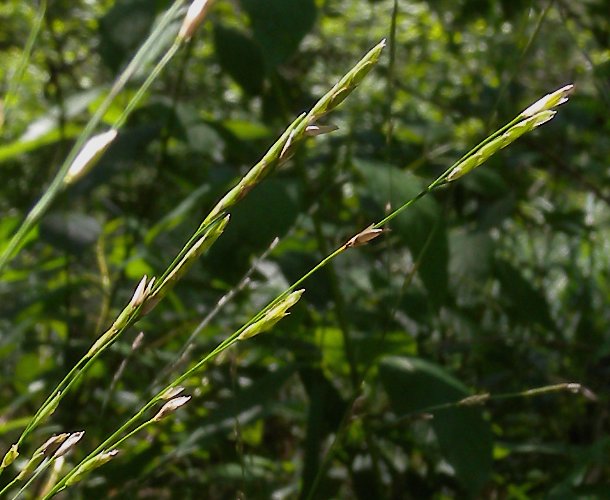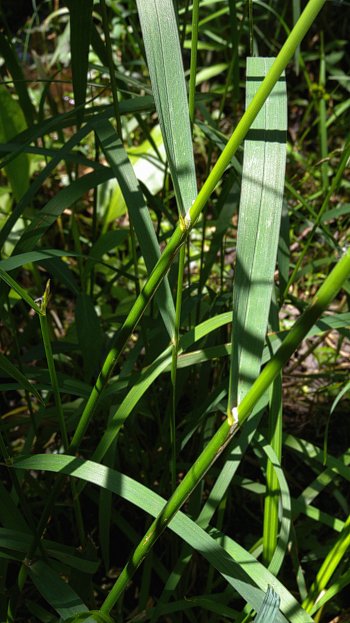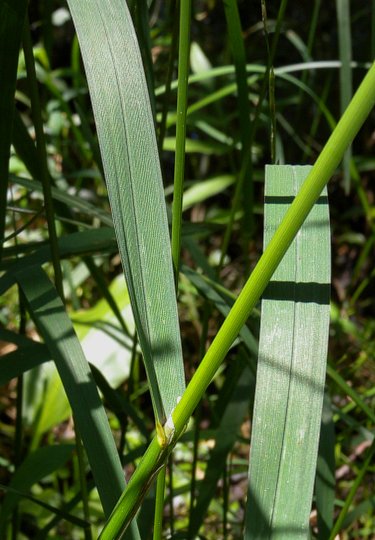
Individual spikelets consist of 2 glumes at the bottom and 6-14 lemmas above; they are organized somewhat loosely into 2 overlapping ranks. One glume is 2-3 mm. in length, while the other glume is 3-4 mm. in length; they are narrowly elliptic to narrowly lanceolate, convex along their outer sides, light green, glabrous or nearly so, and single-veined. The lemmas are 4-5 mm. long and narrowly elliptic to narrowly oblanceolate, convex along their outer sides, light green, and 5-7 veined. Although they appear to be glabrous without inspection from a hand lens, the lemmas usually have minute stiff hairs between their veins that provide a slightly rough texture. The tips of the lemmas are often chaffy and obtuse. The paleas are about the same size and shape of the lemmas. The floret of each lemma has a pair of feathery stigmata and 3 anthers. The blooming period can occur from late spring to late summer, lasting about 1-3 weeks. Afterwards, the spikelets become light tan shortly afterward as their grains ripen. Disarticulation is above the glumes and between the lemmas. The grains are narrowly elliptic. The root system is fibrous and rhizomatous. The bottom of each culm is often decumbent and may develop roots along its lower nodes, forming clonal offsets.

Cultivation: The preference is full or partial sun, wet conditions, and soil containing loam, clay, or sand with organic material. Shallow water is readily tolerated. This grass may spread aggressively in some situations.
Range & Habitat: The native Eastern Manna Grass is occasional in NE Illinois and uncommon to absent elsewhere in the state (see Distribution Map). Habitats include floodplain forests, swamps, marshes, margins of ponds and lakes, sloughs, and sink holes. These habitats consist of both sandy and non-sandy wetlands.
Faunal Associations: Insects that feed on Eastern Manna Grass and other Glyceria spp. (Manna Grasses) include Sphenophorus missouriensis (Missouri Billbug), larvae of a moth, Apamea impulsa (Southern Quaker), and such aphids as Carolinaia howardii, Metopolophium dirhodum (Rose-Grass Aphid), Rhopalomyzus poae, and Rhopalosiphum oxyacanthae (Apple-Grass Aphid); see Vaurie (1983), Panzer et al. (2006), and Blackman & Eastop, 2013. Among vertebrate animals, muskrats sometimes feed on the culms (Hamerstrom & Blake, 1939), while wood ducks feed on the grains (Martin et al., 1951/1961). The foliage is palatable to cattle, horses, and other mammalian herbivores, but Eastern Manna Grass is usually found in inaccessible wetlands.

Photographic Location: A swamp at the Indiana Dunes State Park in NW Indiana.
Comments: The common name of this grass refers to the sweet-tasting grains of a closely related species, Glyceria fluitans (Floating Manna Grass), which is native to both North America and Eurasia. This latter grass has a more northern distribution than Eastern Manna Grass and it is somewhat shorter. Eastern Manna Grass belongs to a group of Glyceria spp. that have long spikelets (exceeding 10 mm. in length) and narrow panicles with erect to ascending branches. It can be distinguished from other species of this group by its wide leaf blades (up to 12 mm. across) and its long lemmas (4-5 mm. in length).